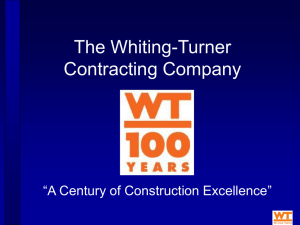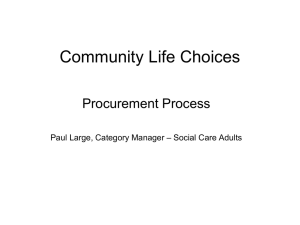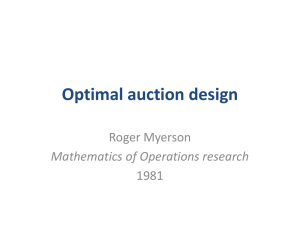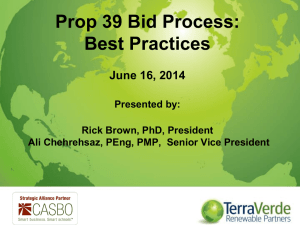Chapter 12: Answers to Questions and Problems
advertisement
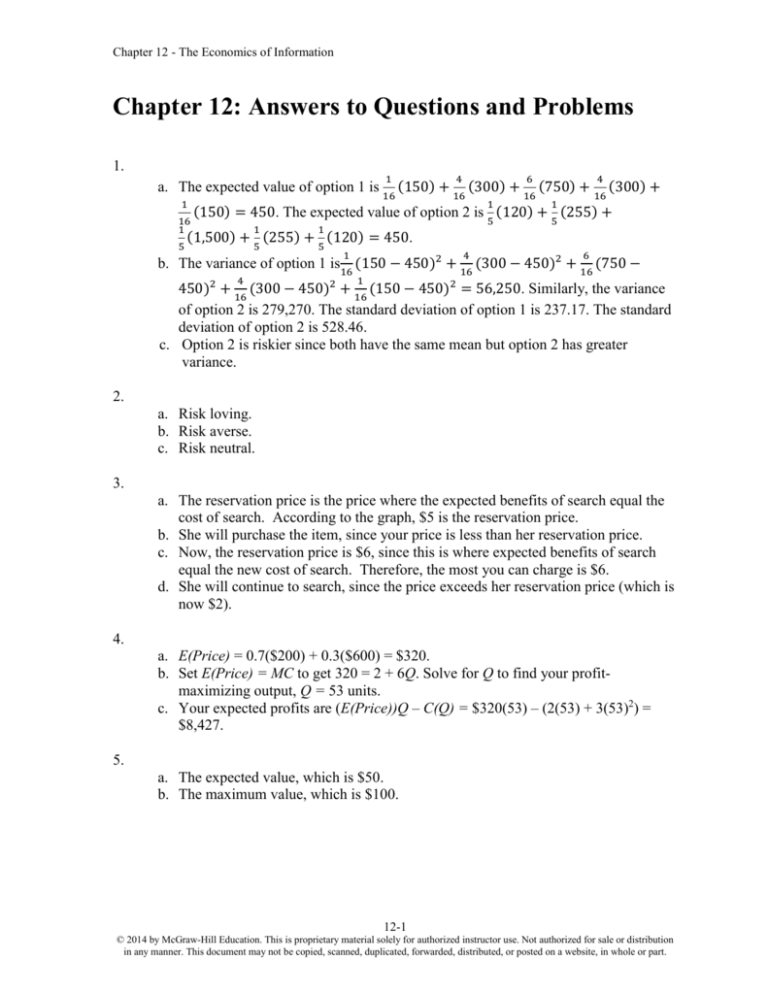
Chapter 12 - The Economics of Information Chapter 12: Answers to Questions and Problems 1. 1 4 6 4 a. The expected value of option 1 is 16 (150) + 16 (300) + 16 (750) + 16 (300) + 1 16 1 5 1 1 5 5 (150) = 450. The expected value of option 2 is (120) + (255) + 1 1 5 5 (1,500) + (255) + (120) = 450. 1 4 6 b. The variance of option 1 is16 (150 − 450)2 + 16 (300 − 450)2 + 16 (750 − 4 1 450)2 + 16 (300 − 450)2 + 16 (150 − 450)2 = 56,250. Similarly, the variance of option 2 is 279,270. The standard deviation of option 1 is 237.17. The standard deviation of option 2 is 528.46. c. Option 2 is riskier since both have the same mean but option 2 has greater variance. 2. a. Risk loving. b. Risk averse. c. Risk neutral. 3. a. The reservation price is the price where the expected benefits of search equal the cost of search. According to the graph, $5 is the reservation price. b. She will purchase the item, since your price is less than her reservation price. c. Now, the reservation price is $6, since this is where expected benefits of search equal the new cost of search. Therefore, the most you can charge is $6. d. She will continue to search, since the price exceeds her reservation price (which is now $2). 4. a. E(Price) = 0.7($200) + 0.3($600) = $320. b. Set E(Price) = MC to get 320 = 2 + 6Q. Solve for Q to find your profitmaximizing output, Q = 53 units. c. Your expected profits are (E(Price))Q – C(Q) = $320(53) – (2(53) + 3(53)2) = $8,427. 5. a. The expected value, which is $50. b. The maximum value, which is $100. 12-1 © 2014 by McGraw-Hill Education. This is proprietary material solely for authorized instructor use. Not authorized for sale or distribution in any manner. This document may not be copied, scanned, duplicated, forwarded, distributed, or posted on a website, in whole or part. Chapter 12 - The Economics of Information 6. a. With only two bidders, n = 2. The lowest possible valuation is L = $1,500, and your own valuation is v = $4,000. Thus, your optimal sealed bid is 𝑏 = 𝑣 − 𝑣−𝐿 $4,000−$1,500 = $4,000 − = $2,750. 𝑛 2 b. With ten bidders, n = 10. The lowest possible valuation is L = $1,500, and your 𝑣−𝐿 own valuation is v = $4,000. Thus, your optimal sealed bid is 𝑏 = 𝑣 − 𝑛 = $4,000−$1,500 $4,000 − = $3,750. 10 c. With one hundred bidders, n = 100. The lowest possible valuation is L = $1,500, and your own valuation is v = $4,000. Thus, your optimal sealed bid is 𝑏 = 𝑣 − 𝑣−𝐿 $4,000−$1,500 = $4,000 − = $3,975. 𝑛 100 7. a. With 5 bidders, n = 5. The lowest possible valuation is L = $10,000, and your 𝑣−𝐿 own valuation is v = $30,000. Thus, your optimal sealed bid is 𝑏 − 𝑣 − 𝑛 = $22,000−$10,000 $22,000 − = $19,600. 5 b. A Dutch auction is strategically equivalent to a first-price sealed bid auction (see part (a)). Thus, you should let the auctioneer continue to lower the price until it reaches $19,600, and then yell “Mine!” c. $22,000, since it is a dominant strategy to bid your true valuation in a secondprice, sealed-bid auction. d. Remain active until the price exceeds $22,000; then drop out. 8. a. Hidden actions lead to moral hazard; hidden characteristics lead to adverse selection. b. Incentive contracts can solve moral hazard problems; screening and sorting can solve adverse selection problems. 9. The discounted price is most likely due to asymmetric information. The seller has better information about the car’s condition than the buyer. The buyer cannot tell whether the low price is due to poor unobservable car characteristics or, e.g., due to the seller needing cash fast and thus being willing to offer a low price. Thus, an adverse selection situation is present. 10. Life insurance policies that will not pay claims arising from suicide are designed to protect the company from the adverse selection problem. Eliminating this clause will likely reduce a life insurance company’s bottom line, since individuals who are contemplating suicide will purchase policies just prior to their death. 11. Since this is a common value auction, bidders will not bid their own private estimates because doing so would lead to the winner’s curse. Thus, there will be an additional incentive for bidders to shade their bids below their estimated valuations. The English auction format provides bidders the most information (therefore allowing them to 12-2 © 2014 by McGraw-Hill Education. This is proprietary material solely for authorized instructor use. Not authorized for sale or distribution in any manner. This document may not be copied, scanned, duplicated, forwarded, distributed, or posted on a website, in whole or part. Chapter 12 - The Economics of Information pool information to some extent), mitigating this problem. For this reason, the English auction would generate the highest expected revenues in this case. 12. Your expected inverse demand is E(P) = .6(300,000 – 400Q) + .4(500,000 – 275Q) = 380,000 – 350Q. Therefore, your expected marginal revenue is E(MR) = 380,000 – 700Q. Your marginal cost is MC = $240,000. Setting E(MR) = MC yields 380,000 – 700Q = 240,000. Solving, Q = 200. The price you expect is thus E(P) = 380,000 – 350(200) = $310,000. Your profits are thus ($310,000 -$240,000)(200) - $140,000 = $13,860,000. 13. One would expect higher premiums on credit life, thanks to adverse selection. People who cannot pass physicals will select toward this type of insurance, resulting in higher premiums. Furthermore, people who are healthy and can pass a physical will be unwilling to pay the higher premiums, thus exacerbating this effect. 14. The expected benefit from an additional search are 0.10($100,000 - $70,000) = $3,000, while the cost of another search is $5,800. Therefore, make her an offer. 15. In the absence of "guaranteed issue," an insurance company could choose to insure only those employees with a very low risk structure. In this case they offer lower rates because they experience fewer claims. But this leaves those workers with greater risk factors without insurance. By requiring insurers to offer coverage to all employees, the insurance company must take on employees that are less healthy and a greater risk. Why the controversy? By insuring those with greater health risks, the expected number of claims rises, thus increasing the cost of coverage. The workers with existing health problems benefit at the expense of healthy workers, who pay higher prices with "guaranteed issue." If the price rises high enough and healthy workers are free to drop coverage, this can result in adverse selection: The only people willing to pay the higher premiums are those in poor health. 16. Brownstown Steel has better information about its financial situation than does its lenders, and is attempting to use this information advantage to enhance its bargaining position. If lenders gained full information about the financial situation of Brownstown Steel Corp., they would be in a position to squeeze the maximum amount from Brownstown Steel without fear of pushing it into bankruptcy. Absent the information, lenders will be more generous, since taking too much would increase the risk that Brownstown Steel goes bankrupt. 17. The 30-day warranty and 10-point inspection. This not only reduces buyer risk from being duped by a used car dealer, but provides a costly signal about the quality of the used cars sold. An unscrupulous dealer would find it costly to mimic this strategy. Recognizing both of these facts, rational buyers will be more willing to purchase cars from the dealer. 12-3 © 2014 by McGraw-Hill Education. This is proprietary material solely for authorized instructor use. Not authorized for sale or distribution in any manner. This document may not be copied, scanned, duplicated, forwarded, distributed, or posted on a website, in whole or part. Chapter 12 - The Economics of Information 18. Offer two plans for customers with more than $1.5 million in assets. One plan (perhaps called the “Free Trade” Account) has an annual maintenance fee of $20,000 good for up to 500 “free” transactions (computed as $20,000/$40) per year (each additional transaction is priced at $40 each). The other plan (perhaps called the “Free Service” Account) has no annual maintenance fee but charges $120 per transaction. Given these two options, investors will sort themselves into the plans based on their individual characteristics. 19. With 4 other bidders, n = 5. The lowest possible valuation is L = $8,000, and your own valuation is v = $16,000. Thus, your optimal first-price, sealed-bid is 𝑏 = 𝑣 − 𝑣−𝐿 $16,000−$8,000 = $16,000 − = $14,400. 𝑛 5 A risk-neutral Oracle’s bid of $7 billion may seem low since the expected value of the 20. present value of the stream of profits is $7.6 billion (= 0.7×10 + 0.3×2). The public bidding process described most resembles a common values auction, since each company is forming different forecasts for a good that has, essentially, the same value for both bidders. Therefore, it is prudent to bid less than your forecasted value to avoid the winner’s curse. However, with new information about SAP’s expected value of the present value of the stream of profits being $8.4 billion (= 0.8×10 + 0.2×2), this should make you a bit more optimistic about the “true” value of the company, and so you should consider raising your bid. 21. The expected value of aggregate ten-year profits of a McDonald’s franchise is 0.25($16) + 0.50($8) + 0.25(-$1.6) = $7.6 million. Similarly, the expected value of a Penn Station East Coast Subs’ franchise is 0.025($48) + 0.95($8) + 0.025($-48) = $7.6 million. The variance and standard deviation of owning a McDonald’s franchise 2 is 𝜎𝑀𝑐𝐷𝑜𝑛𝑎𝑙𝑑𝑠 = 0.25(16 − 7.6)2 + 0.50(8 − 7.6)2 + 0.25(−1.6 − 7.6)2 = 38.88 2 and 𝜎𝑀𝑐𝐷𝑜𝑛𝑎𝑙𝑑𝑠 = √𝜎𝑀𝑐𝐷𝑜𝑛𝑎𝑙𝑑𝑠 = √38.88 = 6.23538, respectively. Similarly, the 2 variance and standard deviation for Penn Station East Coast Subs’ is 𝜎𝑃𝑒𝑛𝑛 = 2 2 2 0.025(48 − 7.6) + 0.95(8 − 7.6) + 0.025(−48 − 7.6) = 118.24 and 𝜎𝑃𝑒𝑛𝑛 = 2 √𝜎𝑃𝑒𝑛𝑛 = √118.24 = 10.8738, respectively. Since the expected values are the same we can compare the standard deviations to determine the most risky investment. Since σPenn > σMcDonalds there is more risk associated with a Penn Station East Coast Subs’ franchise. 22. There are several things for a student to consider in deciding to enroll in a traditional MBA program or an online MBA program. It is likely that students with a spouse and family will be more attracted to online MBA programs, since these individuals tend to value stability and have others relying on them for income. In contrast, traditional MBA programs are more likely to attract singles who are willing to bear the opportunity cost associated with this form of education. Thus, online MBA programs can serve as a screen, helping potential employers learn more about candidates from each type of program. If they need a more flexible employees (e.g., one that might be willing to travel or move frequently), these are more likely to be found in a traditional MBA program. If they are looking for more stable employees, these are more likely to be found in an online MBA program. 12-4 © 2014 by McGraw-Hill Education. This is proprietary material solely for authorized instructor use. Not authorized for sale or distribution in any manner. This document may not be copied, scanned, duplicated, forwarded, distributed, or posted on a website, in whole or part. Chapter 12 - The Economics of Information 23. Market collapse is likely when individuals are allowed to engage in insider trading. This is because “outsiders” will be unwilling to participate in equity (or other) markets since they know “insiders” will only sell a stock when they know the price is too high. Similarly, insiders will only buy when the price of a stock is known to be low. This is a losing proposition for outsiders, who would rationally choose not to participate in the market. This is an example of a adverse selection and is one of the primary reasons the SEC exists. 12-5 © 2014 by McGraw-Hill Education. This is proprietary material solely for authorized instructor use. Not authorized for sale or distribution in any manner. This document may not be copied, scanned, duplicated, forwarded, distributed, or posted on a website, in whole or part.


